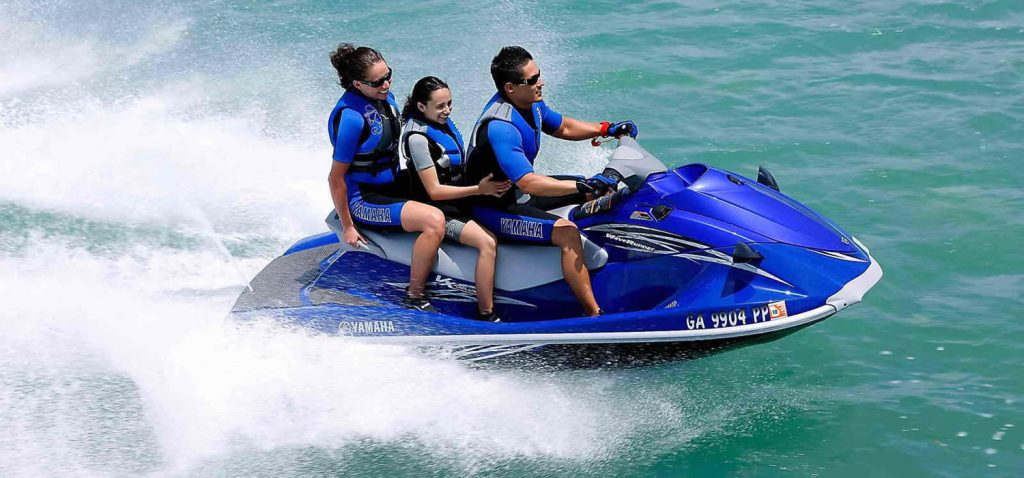
There is nothing like traversing the open ocean on a jet ski. This small personal watercraft, also known as a PWC or waverunner (for Yamaha-branded models), has evolved from a beach fad into an essential part of the pro racing circuit.
But before you jump on board, there are a few things you should know.
What is a jet ski?
A jet ski is a type of personal watercraft that is similar to a motorcycle and has a rider sitting on top of it. They are one of the most popular types of watercrafts on the water and can be very fun for people who have never ridden one before. However, because they are so maneuverable and can travel at high speeds, they are also very dangerous if operated by inexperienced or reckless drivers.
The term “jet ski” is a branded name that was first used by Kawasaki, but it has since become synonymous with personal watercrafts in general. They are also known as PWCs (personal watercrafts) and sometimes by brand names such as WaveRunner (Yamaha) and Sea-Doo (Bombardier).
Jet skis are different from traditional motor boats because they use an impeller instead of a propeller. The impeller pulls water into a propulsion channel and then forces it out through a size restricted jet nozzle to create thrust. The nozzle can be moved from side to side by using the handlebar mounted on the hull, which allows the jet ski to turn.
Most PWCs have a maximum speed of about 62 miles per hour, and can even go faster with the addition of performance parts. This speed limit is set because it prevents PWCs from creating a wake that could damage other boats or pose a danger to swimmers. It is also important to respect no-wake zones, which are usually marked with floating cones.
Safety tips
Jet skis can be a lot of fun, but like any other type of motor-powered watercraft they pose the possibility of serious injury or death. The first step towards avoiding accidents on the water is taking a safety course and adhering to regulations. This will reduce the chance of an accident regardless of your experience level.
While it may be tempting to speed, excessive speeds can cause collisions with other watercraft, swimmers and even larger boats. Considering that most Jet Skis do not have brakes, it is best to maintain a safe distance between yourself and other vessels.
Another way to prevent injuries is to wear protective gear, especially wetsuit bottoms. This is not just to prevent chafing and rips from contact with the water, but also to protect against internal injury. Jet skis accelerate by releasing a high-pressure stream of water, and it is possible for this to enter a passenger’s body cavity and rupture internal organs.
Lastly, it is important to check on the condition of your jet ski before heading out. Look for signs of damage to the hull or other parts, and make sure that the engine is working properly. It is also a good idea to have a two-way radio and first aid kit on board in case of emergency. While it may seem inconvenient to perform repairs before you hit the water, it is far better than risking your life on the water because of faulty equipment.
How to drive a jet ski
If you have never operated a jet ski before, it may take some practice to get comfortable with the controls and handling. Riding a jet ski is easier for those who are familiar with operating small boats or other personal watercrafts, but anyone can learn with patience and safety guidelines. It is also important to wear a life jacket at all times, whether you are riding alone or with other people on the craft. This will help you stay afloat if you fall off and will prevent your jet ski from accidentally starting up if someone else is driving it. It is also a good idea to use a safety lanyard, which is a cord that connects you to your jet ski and forces its engine to shut down if you fall off. This can be attached to a wristband or to your life jacket and is a vital part of the safety gear on any watercraft.
When riding a jet ski, it is important to keep your body relaxed and lean slightly forward. This will reduce the likelihood of soreness or muscle strain in your shoulders and back. In addition, be careful when jumping wakes or waves as these can be very dangerous for a beginner rider. Finally, remember that jet skis do not have brakes and should only be driven at a safe speed.
Buying a jet ski
When buying a jet ski, be sure to research models and read reviews before making any decisions. Taking a test ride is also essential to ensure the model you choose will fit your body type and riding style. If you’re new to the sport, consider choosing a model from the Recreation category as they are stable and perfect for beginners. If you’re looking to go faster, there are lots of performance parts available that can take a PWC up to 62 mph.
Check the watercraft’s title and log books before you buy, and pay attention to whether or not the model has been tampered with in any way. If you see any service stamps that don’t match, it could be a sign that the owner hasn’t maintained the jet ski properly. Also, take a close look at the seats: if they’re torn up, it may indicate that they’ve been used for jumps and other tricks.
Look at the hull, too. Small dents and marks are normal, but if you can see chunks missing from the fiberglass, it’s probably not a good idea to purchase it. Finally, check the trailer to make sure it’s in working order. It’s pretty useless if it’s not able to transport your PWC to and from the water.